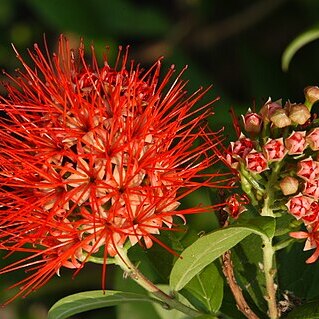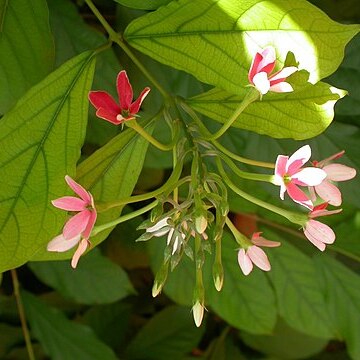Trees, shrubs, or woody lianas, evergreen or deciduous, rarely subherbaceous. Indumentum of simple hairs, glandular hairs, or multicellular hairs secreting calcium oxalate and forming scales or present beneath cuticle and making leaf blade surface verruculose and sometimes translucent dotted. Leaves opposite, subopposite, whorled, spiraled, or alternate, usually petiolate, estipulate; petiole sometimes persistent and thornlike; leaf blade simple, margin entire or subentire, sometimes toothed, glands often present between crenations of proximal margin and at base or on petiole. Inflorescences terminal, axillary, or extra-axillary, spikes, branched spikes, racemes, panicles, or sometimes capitula, bracteate. Flowers usually regular, rarely slightly zygomorphic, usually bisexual, sometimes bisexual and male flowers present in same inflorescence. Receptacle surrounding and adnate to ovary and extended into a short or long calyx tube dilated distally (together termed "calyx tube" in this treatment); lobes 4 or 5(-8), valvate in bud, persistent or deciduous, sometimes almost absent. Petals 4 or 5, inserted near mouth of calyx tube, imbricate or valvate in bud, conspicuous or not, or absent. Stamens usually 2 × as many as calyx lobes in 2 series, inserted inside distal part of calyx tube, included in or exserted from calyx tube; filaments incurved in bud; anthers dorsifixed, usually versatile, dehiscing longitudinally. Disk usually present, intrastaminal, hairy or glabrous. Ovary inferior, 1-loculed; ovules 2(-6), pendulous, anatropous, usually only 1 developing; style 1, simple, usually free from distal part of calyx tube, subulate to filiform; stigma capitate or inconspicuous. Fruit a pseudocarp, very variable in shape and size, fleshy or dry, 1-seeded, usually indehiscent, often longitudinally 2-5-winged,-ridged, or-angled; endocarp not or at least partly sclerenchymatous. Cotyledons convolute, folded, or twisted. Endosperm absent.
Trees, shrubs or lianes, sometimes armed. Leaves verticillate, opposite, spirally arranged or alternate, often with domatia, simple, entire, exstipulate. Flowers bisexual or male, 4-or 5-merous, regular, arranged in axillary or subcapitate spikes or racemes, or (in Macropteranthes) single or in pairs in axils. Calyx usually of 2 parts; the receptacle (lower part), adnate to the ovary, and the calyx tube (upper part), terminating in the calyx lobes; lobes 4 or 5, rarely 6–8. Petals 4 or 5 (or absent), inserted near mouth of calyx tube. Stamens usually twice as many as the petals, inserted inside calyx. Disc intrastaminal. Ovary inferior, 1-locular; ovules pendulous, 2–20. Style simple. Fruit drupaceous or dry, usually indehiscent, often variously winged or ridged, 1-seeded. Seed without endosperm. See also Du Puy & Telford 1993: 243).
Receptacle (calyx-tube or hypanthium) usually in two distinct parts, the lower receptacle surrounding and adnate to the inferior (except in Strephonema from West Africa) ovary and upper receptacle usually produced beyond it to form a short or long tube (perhaps a true calyx-tube in Meiostemon) terminating in the sepals (calyx-lobes), the latter sometimes scarcely developed
Stamens usually twice as many as the sepals or petals but occasionally the same number (4 in Meiostemon), borne inside the upper receptacle with biseriate or more rarely uniseriate insertion (one whorl very rarely as staminodes), exserted or included; anthers dorsifixed, versatile (rarely adnate to the filaments, but not in our area)
Flowers bisexual or bisexual and male in the same inflorescence or very rarely dioecious, usually 4–5-merous, rarely slightly zygomorphic, in axillary or extra-axillary elongated or subcapitate spikes or racemes or in terminal or axillary panicles
Indumentum of unicellular compartmented (rarely non-compartmented) hairs, multicellular stalked glands and multicellular scales (in which the head consists of a multicellular plate only one cell thick)
Fruit (a pseudocarp) very variable in size and shape, fleshy or dry, stipitate or sessile, usually indehiscent (occasionally tardily dehiscent) often variously winged or ridged, 1-seeded
Petals 4 or 5 (rarely more) or absent, conspicuous or sometimes very small, usually inserted near the mouth of the upper receptacle (but near the disk in Meiostemon)
Ovary inferior (semi-inferior in Strephonema), 1-locular with usually 2 (up to 6) pendulous anatropous ovules of which only 1 usually develops
Ovary inferior, rarely half-inferior, 1-celled; style simple; ovules 2–6, suspended from the apex of the ovary by slender funicles
Style usually free (attached to the upper receptacle for part of its length in Quisqualis and a very few species of Combretum)
Leaves opposite, verticillate, spiral or alternate, exstipulate, simple and almost always entire (very rarely crenulate)
Stamens 4–10, rarely more; filaments inflexed in bud; anthers versatile, didymous, opening lengthwise by slits
Seed pendulous, without endosperm; embryo with convolute, plicate or contorted cotyledons and small radicle
Sepals 4 or 5 (rarely 6 or 8) or almost absent, sometimes accrescent (Calycopteris in Asia)
Cotyledons 2 (rarely 3 or 4) occasionally with their petioles connate almost to the apex
Flowers spicate or racemose, mostly small, hermaphrodite, rarely unisexual
Disk intrastaminal, hairy or glabrous, sometimes inconspicuous or absent
Leaves opposite, alternate or rarely verticillate, simple, exstipulate
Calyx-tube adnate to the ovary; limb 4–8-fid or-lobed, lobes valvate
Petals 4–5 or none, rarely many, small, imbricate or valvate
Trees, shrubs, shrublets or climbers, rarely subherbaceous
Fruit often winged, rarely dehiscent
Trees or shrubs, often scandent
Albumen absent
Disk epigynous


